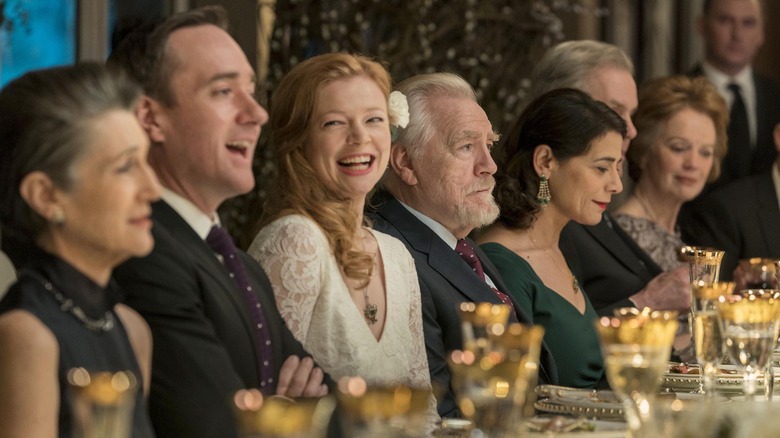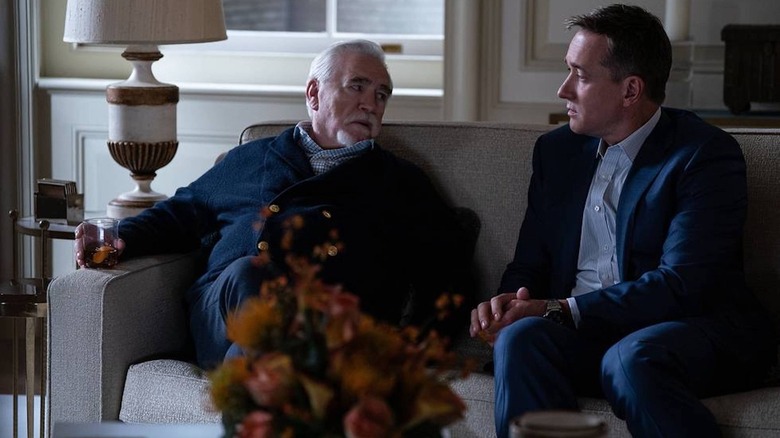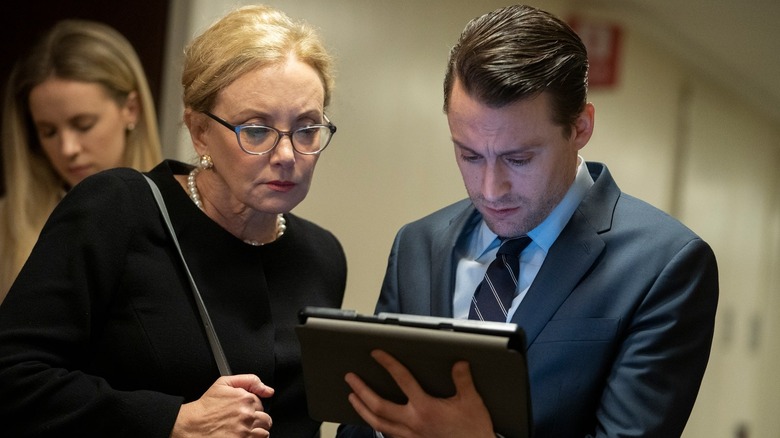Succession's Camera Crew Constantly Keeps The Cast On Their Toes
There's nary a scene in "Succession" that doesn't leave me wondering: Should I be laughing, crying, or cringing, if not all three at once? Without fail, creator Jesse Armstrong's satirical examination of the One Percent manages to transition gracefully from soul-wrenching drama in one moment to something as jaw-dropping as "Boar on the Floor" in the next. Obviously, writing is a huge part of that. "Succession" boasts some of the sharpest storytelling on TV right now, yet it's very much a group effort. If the cast wasn't spot-on with their performances, Armstrong's Shakespearean tragedy by way of dark comedy wouldn't have nearly the bite it does.
"The thing for me that's most important is the harmony of the group," said Brian Cox, speaking to The Wrap in August 2022. As Logan Roy, the King Lear figure (by way of Rupert Murdoch) of "Succession," Cox seems to appreciate his peers in a way his onscreen counterpart never has. It's that "harmony" that functions as the key ingredient to the series' alchemy, Cox argued, more than any single performance. "It's all these wonderful individual actors coming together where they create something extraordinary," he explained.
"We don't do this alone. We do this in tandem with a lot of other people who are trying to be all for one, as it were. A unit," Cox added. Indeed, for as much as the show's incredible actors and, by extension, their characters thrive from playing off one another, there's one particularly vital contributor that doesn't always get their due credit. That would be the camera crew and the very camera itself, which video essayist Thomas Flight has previously described as "The 'Succession' Character You Never See."
'You can't be an island'
Thomas Flight has argued that "Succession" utilizes a subjective, observational approach to its cinematography that has less in common with the larger U.S. TV landscape, and hews closer to the stylings of something like Thomas Vinterberg's 1998 film "The Celebration." The show is full of what might come across as clumsy camerawork under different circumstances: imprecise framing, ungainly shifts in focus, jerky pan-aways. However, "Succession" is very deliberate in the way it uses these techniques. Combined, they allow the camera to imitate the perspective of an offscreen character, reacting in real-time to whatever's happening in a given scene.
In order to create this impressionistic visual style, "Succession" is often filmed in long takes, especially during the scenes that involve multiple characters interacting. "As an actor, they're fantastically exciting and satisfying and then daunting to play because they are sometimes 10-page scenes," explained Matthew Macfadyen, who co-stars as the pathetic, pitiable Tom Wambsgans. "And so you have to rely on your fellow actors. You can't be an island," he added, further highlighting just how much the show's cast has to stay on their toes, even when the camera isn't focused on them.
"There's just a lot of trust," noted Nicholas Braun, who, as Cousin Greg, forms the other half of the "Disgusting Brothers" with Tom. "In a scene with three characters or a scene with 15 characters, everyone knows their role so well and knows the rhythms of our show so well and knows when you can improv or when you can fill in a gap or when you let somebody else have it," he continued.
If that sounds a lot like theater acting, that's because it is. There's a good reason so many "Succession" actors have an extensive background performing on stage, Macfadyen included.
Finding what's most interesting
While the cameras might be constantly rolling on the "Succession" set, the final episodes are heavily edited and rarely feature long takes. It's yet another reason why the show's cast has to be habitually vigilant during any specific scene. For all they know, the series' creatives could just as well decide to use a shot of them silently reacting to someone else or doing some innocuous action, instead of a closeup of their face while they're going for the Emmy.
"There's always this little nip in the air of improv. You're saying the scene as written, but the cameras are voyeuristically on the move and you don't know when someone else may be speaking, but they may be looking at you putting an ice cube in your drink because it's funny," said J. Smith Cameron, who plays the scene-stealing veteran Waystar RoyCo executive Gerri Kellman. To build upon Cameron's comments, the subjective camerawork in "Succession" is ultimately in service of a simple goal: finding what's most interesting in any moment of any particular scene. This approach has clearly served the series well, bringing out the best in its actors and emboldening them to always stay firmly present in the action, whether it directly concerns their character or not.
"It encourages you to be really involved every second and to be listening because that's where the juicy things happen. You're on your toes in the best way," Cameron added.
"Succession" airs on HBO and streams on HBO Max on Sundays at 9 p.m. ET.


